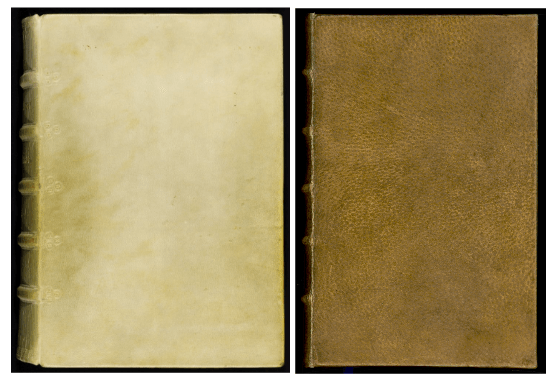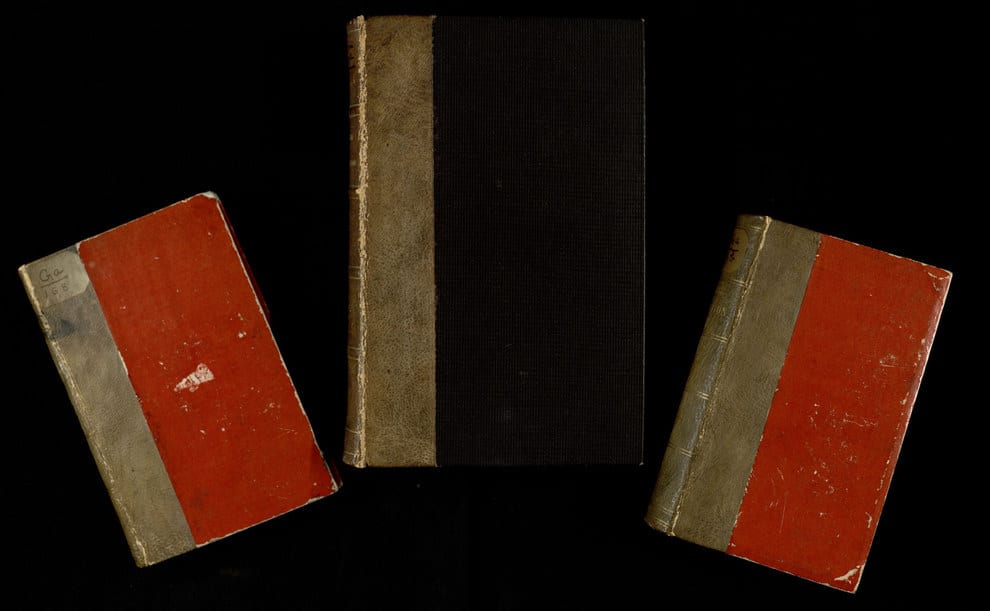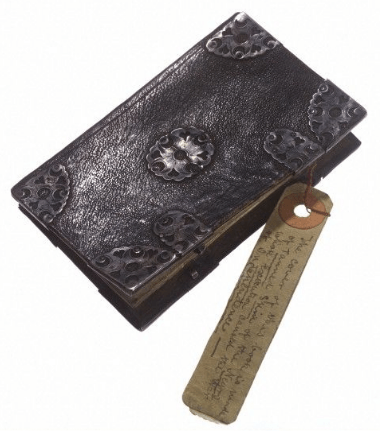The People Who Became Book Bindings
By Arendse I Lund, on 31 October 2016
 by Arendse Lund
by Arendse Lund
The softness of the leather, the beauty of the decoration—we just can’t help it, we judge a book by its cover. Yet, when we hold a book in our hands, how good of judges are we as to what it’s made of?
Leather bindings are generally made from calfskin, sheepskin, or goatskin. (Traditionally, goatskin is referred to as Morocco leather.) It’s surprisingly difficult to tell these apart at a glance, and you’ll sometimes see labels stating two possibilities for the make of the bindings. This becomes even more complex when you throw in a fourth option: Anthropodermic bibliopegy. Otherwise known as books bound in human skin, these rare editions became popular in the 18th century although it’s uncertain when exactly the practice started.

Left, white pigskin binding (British Library, Add MS 59678); Right, human skin binding (Houghton Library, FC8.H8177.879dc)
However difficult it is to tell animal bindings apart, certainly we must be able to discern human skin bindings at a glance? Not so. UC Berkeley long held a book which it believed to have been bound in human skin. As this video from the Bancroft Library shows, it’s only by performing tests on the book that we’re able to know for certain. This opens an avenue for an unscrupulous bookseller, looking to increase the price of a particular book, to pass it off as something else. There’s simply no special smell or feel which acts as a dead giveaway; without testing it directly, we just can’t tell for certain.
For instance, one book in the Wellcome Library was rumored to be bound in the skin of Crispus Attucks, killed in the Boston Massacre. A note on paper attached to the clasp of the book reads: “The cover of this book is made of Tanned Skin of the Negro whose Execution caused the War of Independence.” This has since been proven false.
The Harvard Law School Library had three books bound in what was thought to be human skin. One provoked extra interest because of the morbid inscription on its final page: “The bynding of this booke is all that remains of my dear friende Jonas Wright, who was flayed alive by the Wavuma on the Fourth Day of August, 1632. King Mbesa did give me the book, it being one of poore Jonas chiefe possessions, together with ample of his skin to bynd it. Requiescat in pace.” Unfortunately for fans of anthropodermic bibliopegy, tests proved that the binding was sheepskin instead. However, it is always possible that the book was rebound.

A pocket book made from Burke (Surgeons’ Hall Museums)
Some books have been tested and turned out to be genuine. The Surgeons’ Hall Museums has a curious pocketbook which has been proven to be anthropodermic bibliopegy. Stamped into the pebbled leather are the words “BURKE’S SKIN POCKET BOOK” and “EXECUTED 28 JAN 1829.” Medical historian Lindsey Fitzharris has noted that anthropodermic bibliopegy was historically done for three reasons: punishment, memorialization, and collection. Burke falls into the first category. He was a notorious serial killer posing as a body snatcher in the early 19th century; under Britain’s Murder Act, when he was caught and convicted, he was publicly dissected so as to be made an example of and his skin used for the bindings. This pocketbook makes no secrets of its background with its embossed cover.

Richly decorated binding using the skin of an unknown woman (Wellcome Collection .b13425110)
By contrast, the cover of Houghton Library’s human skin book is free from decoration; the man who bound it wrote, “This book is bound in human skin parchment on which no ornament has been stamped to preserve its elegance. By looking carefully you easily distinguish the pores of the skin. A book about the human soul deserved to have a human covering: I had kept this piece of human skin taken from the back of a woman. It is interesting to see the different aspects that change this skin according to the method of preparation to which it is subjected. Compare for example with the small volume I have in my library, Sever. Pinaeus de Virginitatis notis which is also bound in human skin but tanned with sumac.” The volume referenced is now in the Wellcome Collection and is a treatise on female virginity.

Three books bound from the skin of Mary Lynch (Mutter Museum)
Philadelphia’s Mutter Museum owns five examples of anthropodermic bibliopegy; startling, three have been bound using the skin of the same woman, Mary Lynch. Lynch, unlike Burke, was not a criminal but a hospital patient who died of trichinosis after a short stay. Her doctor was responsible for taking her skin and using it to bind the books. The female subject matter of these books—Speculations on the Mode and Appearances of Impregnation in the Human Female, Le Nouvelles Decouvertes sur Toutes les Parties Principales de L’Homme et de la Femme, and Recueil des Secrets de Louyse Bourgeois—suggests a perceived connection between the interior and exterior of the books. Similarly, one 1793 edition of the Marquis de Sade’s Justine Et Juliette, an erotic novel, was rumored to have used the skin from a woman’s breast.

An inscription memorializing Mary Lynch in one of the books bound in her skin (Mutter Museum)
The practice of anthropodermic bibliopegy ended in the late 19th century and there are no known 20th century examples. It’s also important to bear in mind that many of the “donors” didn’t give their consent and—in the case of Burke and other criminals—using their skin in bindings was an additional means to publicly make an example of them. It would certainly be illegal today, yet many museums and libraries contain books which make this dubious claim to notoriety. However, historically it has been difficult to verify the truth behind such claims. With the advent of peptide mass fingerprinting, a test which analyzes the remaining proteins, bindings can finally undergo tests with little to no damage. The Anthropodermic Book Project is working to identify human skin bindings for books and, at last count, have confirmed 18. While there have never been very many cases of anthropodermic bibliopegy, now that libraries are able to test their books without harming them, we’re bound to discover additional examples.
7 Responses to “The People Who Became Book Bindings”
- 1
-
2
alchemist_cafe wrote on 31 October 2016:
RT @ResearchEngager: Can you tell what these books are bound in? @arendse writes about how hard it is to spot books made from human skin. h…
-
3
Stacy Hackner wrote on 31 October 2016:
For more on human skin in museum collections, check out former Engager Gemma Angel’s blog post: https://blogs.ucl.ac.uk/researchers-in-museums/2013/04/01/painted-skins-butterfly-wings/
-
4
arendse wrote on 31 October 2016:
Calfskin, sheepskin, goatskin, and… humanskin? The creepy history of human skin being used for binding books:… https://t.co/LvI1laAthR
-
5
ResearchEngager wrote on 1 November 2016:
In case you missed it: books bound in human skin! https://t.co/oq5yIM9zwy
-
6
Sabeera wrote on 23 November 2016:
Great piece on an astonishing topic!! It seems we as humans have no option for nauseating punishments unscathed.
-
7
Humberto Moya wrote on 18 August 2018:
A very interesting article on book binding ( ! ). The style is elegant that makes reading very enjoyable.
 Close
Close




Can you tell what these books are bound in? @arendse writes about how hard it is to spot books made from human skin… https://t.co/yl4FEWA8cH